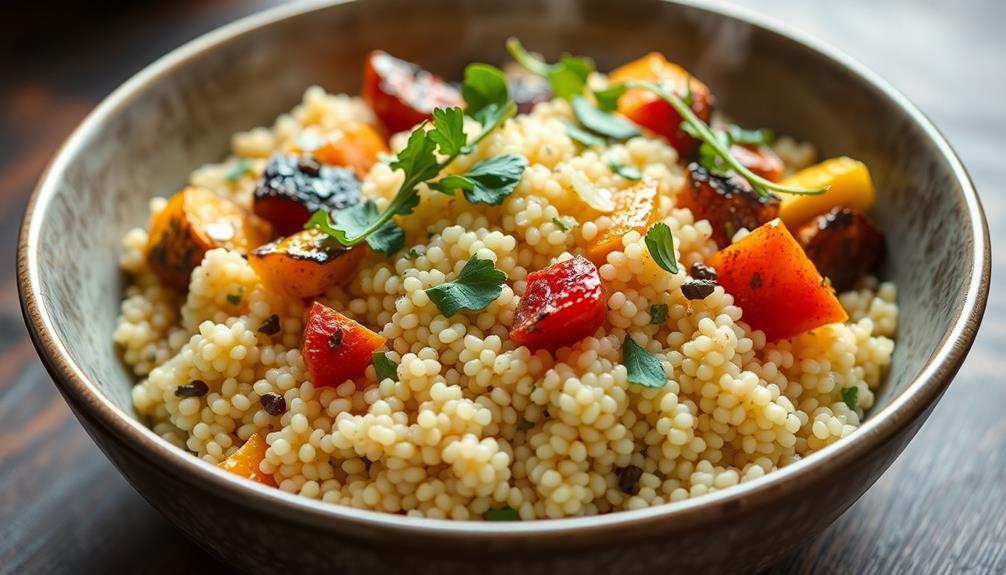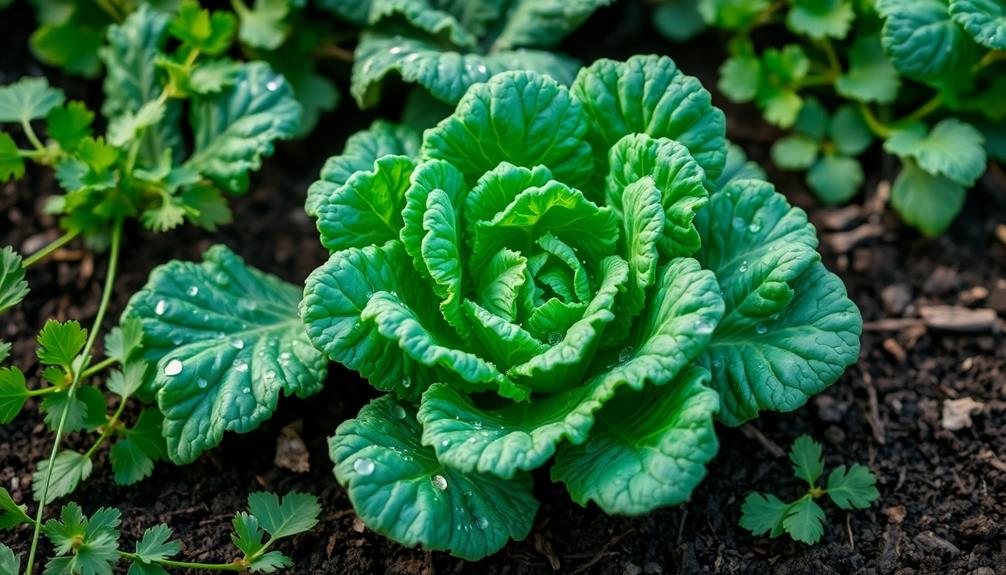Ready to brew your own kombucha at home? It's easier than you think! Start by gathering simple ingredients – filtered water, white sugar, black tea, a SCOBY, and some unflavored kombucha. Steep the tea, dissolve the sugar, then add the SCOBY and let it ferment for 7-14 days. After that, transfer the kombucha to airtight bottles and let it carbonate for a couple days. Chill it, and you've got your very own homemade kombucha! The best part? You can experiment with all sorts of fruit juices and spices to create your perfect flavor. Keep reading to master the art of kombucha brewing.
Key Takeaways
- Gather the essential ingredients: filtered water, white sugar, black tea, SCOBY, and unflavored kombucha from a previous batch or store-bought.
- Brew the sweetened black tea, cool it to room temperature, and add the SCOBY to start the fermentation process.
- Ferment the kombucha in a warm, dark area for 7-14 days, adjusting the duration based on your desired tartness.
- Transfer the fermented kombucha to airtight bottles, optionally adding fruit juice or fresh fruit for additional flavor.
- Refrigerate the bottled kombucha to slow the fermentation and preserve the flavor, enjoying the unique effervescent taste.
History

The origins of kombucha can be traced back thousands of years, with the fermented tea beverage first emerging in ancient China and spreading throughout Asia.
It's believed that kombucha was originally consumed for its purported health benefits, as the drink contains probiotics and various acids that may support immune function and digestion.
Over time, the production and popularity of kombucha grew, with the drink eventually making its way to the Western world in the early 20th century.
Today, kombucha is enjoyed by people all over the globe, not just for its potential health perks but also for its unique, slightly effervescent flavor.
Whether you're new to the world of kombucha or a seasoned enthusiast, learning to brew it at home can be a rewarding and cost-effective experience.
With the right ingredients and a little patience, you can create your own custom blends and enjoy the countless benefits of this ancient elixir.
Recipe

Kombucha is a popular fermented tea that has gained significant popularity in recent years for its purported health benefits. This easy-to-follow recipe will guide you through the process of making your own delicious kombucha at home.
Kombucha is brewed by fermenting sweetened black or green tea with a symbiotic culture of bacteria and yeast, known as a SCOBY (Symbiotic Culture of Bacteria and Yeast). The fermentation process transforms the tea into a slightly effervescent, slightly acidic, and slightly sweet beverage that's packed with probiotics and other beneficial compounds.
- 1 gallon (4 liters) of filtered water
- 1 cup (200 grams) of white sugar
- 8 black tea bags or 4 tablespoons (8 grams) of loose-leaf black tea
- 1 SCOBY (Symbiotic Culture of Bacteria and Yeast)
- 1 cup (240 ml) of unflavored kombucha from a previous batch (or store-bought)
To make the kombucha, bring the filtered water to a boil in a large non-reactive pot. Remove the pot from the heat and add the sugar, stirring until it has fully dissolved.
Add the black tea and let it steep for 5-7 minutes. Remove the tea bags or strain out the loose-leaf tea. Allow the tea to cool to room temperature.
Once the tea has cooled, pour it into a clean, non-reactive fermentation vessel (such as a glass jar or ceramic crock). Add the SCOBY and the cup of unflavored kombucha from a previous batch.
Cover the vessel with a clean cloth or paper towel, secured with a rubber band or string. Allow the kombucha to ferment at room temperature, out of direct sunlight, for 7-14 days, depending on your desired level of tartness.
When the kombucha has reached your preferred flavor profile, you can transfer it to bottles for a second fermentation, which will add more carbonation. Enjoy your homemade kombucha!
Cooking Steps

First, you'll brew a batch of tea and stir in some sugar.
Once it's cooled, you'll add a SCOBY to the sweet tea and cover the jar.
Now, let the mixture ferment for 7 to 14 days before bottling and refrigerating your homemade kombucha.
Step 1. Brew Tea, Add Sugar, Let Cool
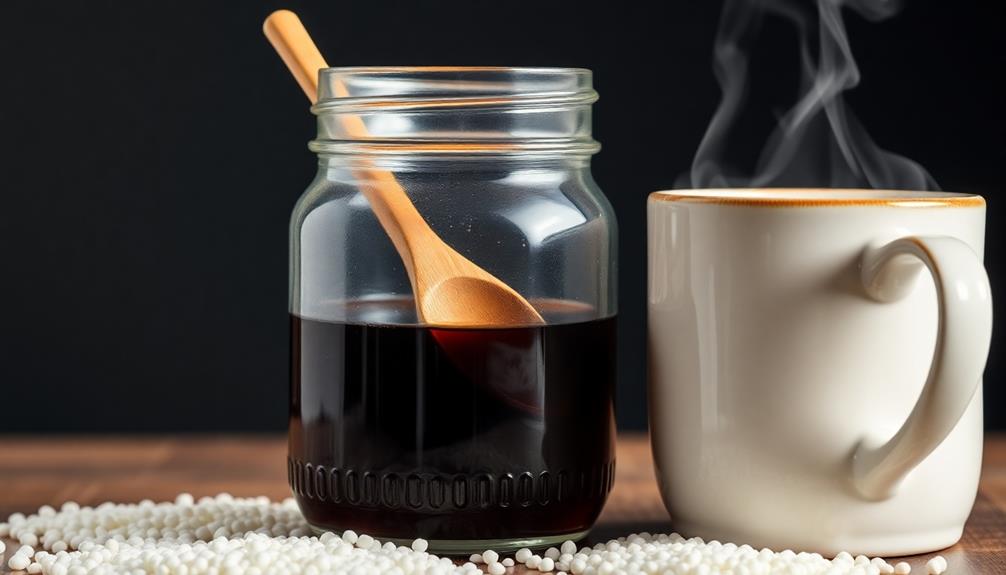
Next, you'll brew your tea. Bring a pot of fresh, filtered water to a boil.
Once boiling, remove from heat and add your tea bags or loose leaf tea. Let the tea steep for 5-7 minutes, allowing the full flavor to infuse the water.
After steeping, discard the tea leaves and let the tea cool to room temperature. This is an important step – the SCOBY (symbiotic culture of bacteria and yeast) won't thrive in hot liquid.
When the tea has cooled, stir in the sugar until fully dissolved. The sugar feeds the SCOBY during fermentation, so use the right amount specified in the recipe.
With your sweetened, cooled tea ready, you can now transfer it to your fermentation vessel. Make sure the container is clean and sanitized to prevent contamination.
Cover the opening with a coffee filter or cheesecloth secured with a rubber band. This allows air flow while keeping dust and debris out.
Now, you're ready for the next stage of the kombucha brewing process!
Step 2. Add SCOBY to Tea
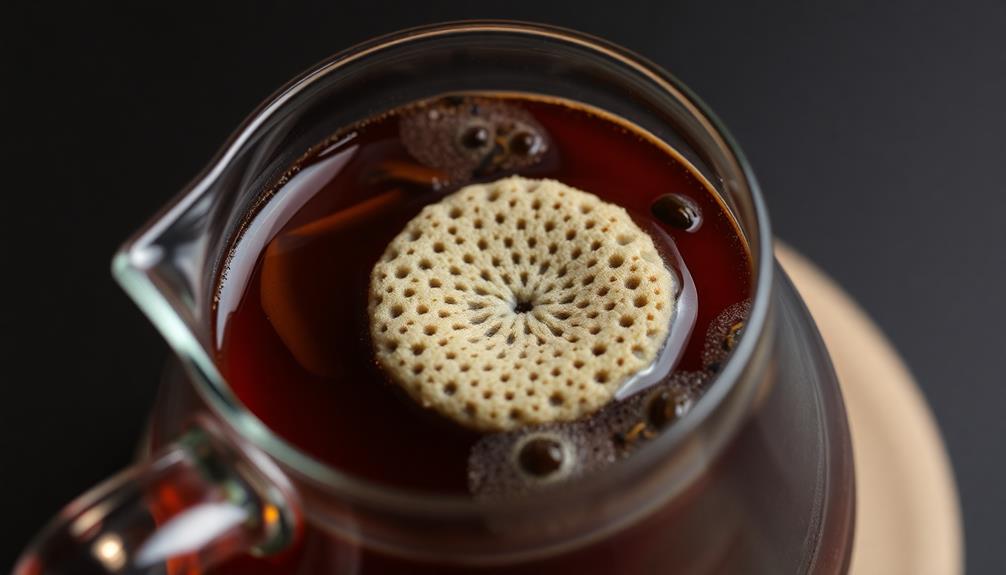
Adding the SCOBY to the cooled, sweetened tea is an exciting step in the kombucha brewing process. This symbiotic culture of bacteria and yeast is the key ingredient that transforms your tea into the effervescent, probiotic-rich beverage, offering various health benefits such as improved digestion and enhanced immune function.
Gently place the SCOBY into the tea, being careful not to disrupt its delicate structure. The SCOBY will slowly sink to the bottom, signaling it has started its work. Don't worry if the SCOBY looks a bit different from the one you've seen – they can come in a variety of shapes and colors. As long as it's healthy, it will do its job.
Cover the container with a breathable cloth or coffee filter and secure it with a rubber band. This allows air to circulate while keeping out dust and debris.
Place the container in a warm, dark spot, like a kitchen cabinet or closet, and let the kombucha ferment. In 7-10 days, you'll have your first batch of homemade kombucha!
Step 3. Cover the Jar
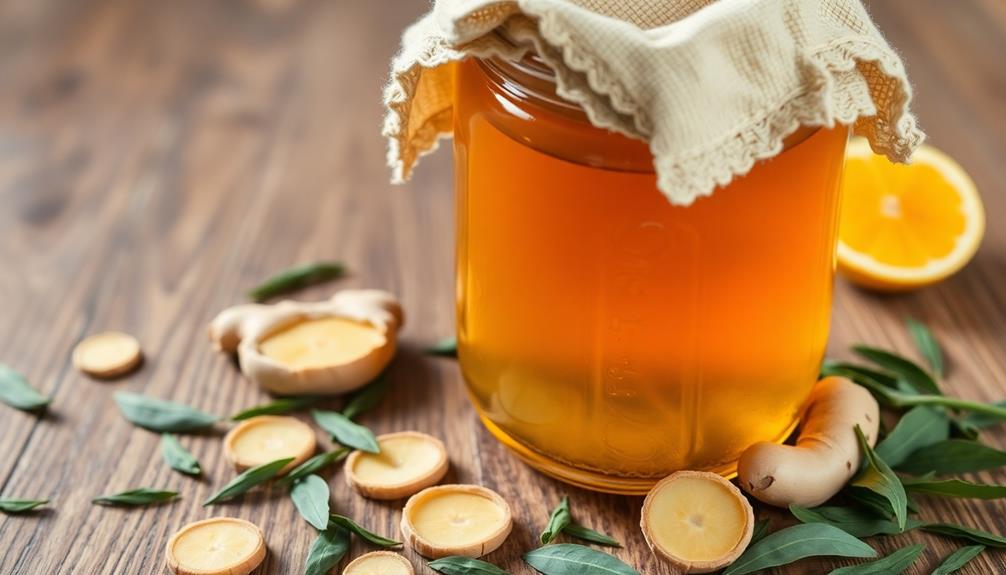
Covering the jar with a breathable cloth or coffee filter is a crucial step in the kombucha-making process. This barrier allows air to flow in and out, which the kombucha culture needs to thrive, while keeping out any unwanted contaminants.
Use a tightly woven towel, paper towel, or coffee filter, and secure it with a rubber band or string. Avoid using plastic wrap or an airtight lid, as this can suffocate the culture and lead to an unhealthy batch. The SCOBY needs to breathe and exchange gases to produce the perfect kombucha.
Once the jar is covered, place it in a warm, dark spot, like a cupboard or pantry. The ideal temperature range is 70-85°F. This environment allows the kombucha to ferment slowly and develop its signature flavor.
Check on it daily, making sure the cover remains in place. With the right setup, your kombucha will be well on its way to becoming a delicious, fizzy delight!
Step 4. Ferment for 7-14 Days
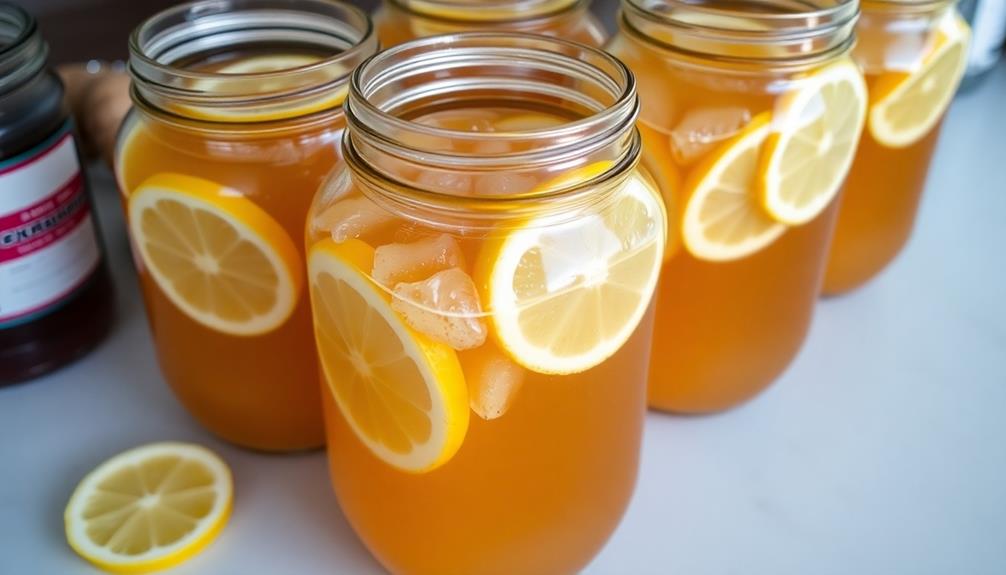
After ensuring the jar is properly covered, allow the kombucha to ferment for 7 to 14 days. This is where the magic happens! During this time, the SCOBY (Symbiotic Culture of Bacteria and Yeast) will work its fermentation powers, transforming the sweet tea into tangy, bubbly kombucha.
Check on your kombucha every few days. You'll notice the SCOBY growing and the liquid becoming more acidic. The longer you ferment, the more tart the flavor will be. Most people ferment for 7-10 days, but you can go up to 14 days if you want a stronger, vinegar-like taste.
When the time is up, the kombucha is ready to drink or bottle for a second fermentation. Carefully remove the SCOBY and reserve it for your next batch.
Then, pour the kombucha into bottles or a pitcher, being sure to leave about an inch at the top. Congratulations, you've just made your own delicious kombucha!
Step 5. Bottle and Refrigerate the Kombucha
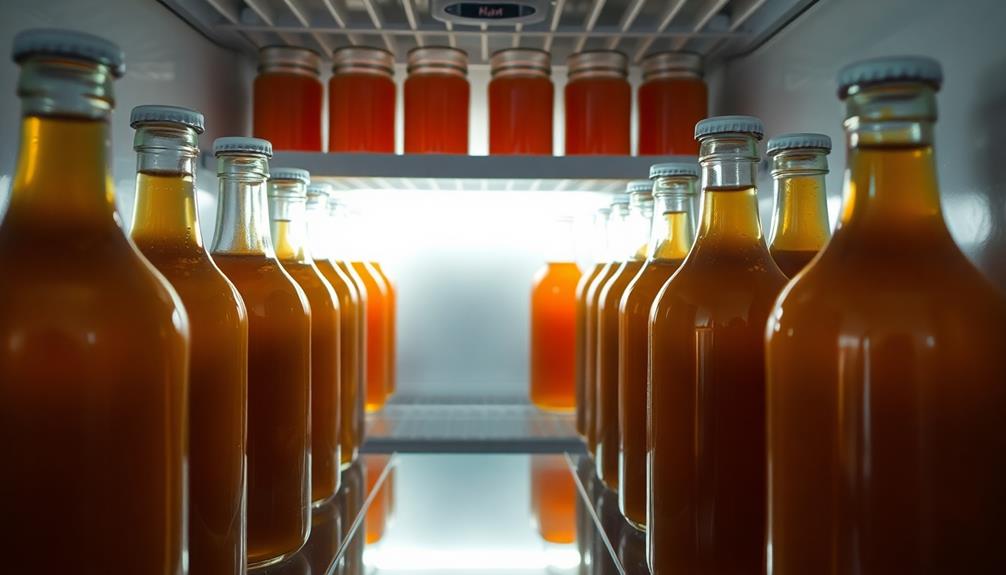
Once the fermentation period has concluded, it's time to bottle your freshly brewed kombucha.
Grab your airtight bottles or jars and carefully transfer the fermented tea into them, leaving about an inch of headspace at the top. If you'd like, you can add a bit of fruit juice or fresh fruit to create a delightful flavor twist.
Just be mindful not to overfill the bottles, as the carbonation can cause them to burst.
Seal the bottles tightly and let them sit at room temperature for an additional 1-2 days. This allows the kombucha to develop more carbonation.
Once satisfied with the fizziness, transfer the bottles to the refrigerator. The cold temperature will slow down the fermentation process, preserving your kombucha's flavour and carbonation.
Enjoy your homemade kombucha chilled, and don't forget to save a bit of the liquid as a starter for your next batch!
Final Thoughts

Homebrewing kombucha allows you to personalize its taste and become an accomplished fermentation artist. With a little practice, you'll perfect the art of crafting your ideal bubbly beverage.
The final thoughts to consider are the endless flavor possibilities, including the use of black tea as a base for your kombucha. Experiment with various fruit juices, spices, and herbs to create unique kombucha blends that suit your palate. Don't be afraid to get creative!
Additionally, remember that the longer you ferment, the more tart and vinegar-like the kombucha will become. Adjust the fermentation time to achieve your desired flavor profile.
Sharing your homemade kombucha with friends and family can also be incredibly rewarding. Watch their faces light up as they discover the delicious, healthy drink you've made.
Enjoy the process of mastering kombucha brewing, and take pride in your transformation from novice to kombucha connoisseur.
Frequently Asked Questions
How Long Does Homemade Kombucha Last in the Fridge?
Homemade kombucha can typically last 2-3 weeks in the fridge. The exact shelf life depends on factors like fermentation time, sugar content, and storage conditions. To maximize freshness, store your kombucha in an airtight container and consume it within 2-3 weeks.
Can I Use a Different Type of Tea for My Kombucha?
Yes, you can use different types of tea for your kombucha. Black, green, white, oolong, and herbal teas all work well. Just be sure to use a high-quality tea and follow the appropriate brewing instructions.
What Are the Health Benefits of Drinking Kombucha?
Drinking kombucha provides numerous health benefits. It's rich in probiotics that support gut health, contains antioxidants that may boost immunity, and some studies suggest it may aid in weight management and blood sugar regulation. Give it a try and experience the benefits yourself!
How Do I Know When My Kombucha Is Ready to Bottle?
You'll know your kombucha is ready to bottle when it develops a thick, leathery SCOBY (symbiotic culture of bacteria and yeast) on top and the liquid has a pleasantly tart, slightly sweet flavor.
Can I Reuse My Kombucha SCOBY for Multiple Batches?
You can reuse your kombucha SCOBY for multiple batches. The SCOBY will continue to grow and thrive, allowing you to perpetually brew new kombucha. Just be sure to provide it with the right conditions to keep it healthy.


